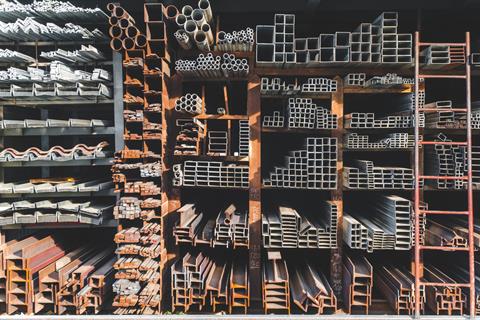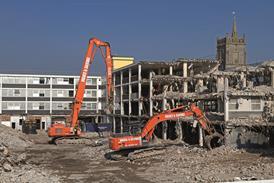As the consultation on the government’s proposals to reform construction product regulation draws to a close, Tom Lowe talks to industry experts about what compromises the government might be making – and what the proposals could mean for the ambition to prevent another tragedy like the fire at Grenfell Tower

“I see some of it as a desperate cry for help,” says Paul Morrell. The former chief construction adviser is talking about the government’s new proposals for regulating construction products. It is fair to say this is not the reaction that ministers will have wanted from the man whose work forms much of the backdrop to the proposed reforms.
The government is currently asking the industry for its views on its proposals to tighten up the regulation of construction products. The 158-page construction products reform green paper is part of the government’s response to the final report of the Grenfell Inquiry, unveiled in February, which also included proposals for a new single regulator for the industry.

Consultation on the green paper closes next Wednesday (21 May), giving those with a professional opinion just over a week to still have their say on what the future of the UK’s construction products regime should look like.
The regulation of construction products is notoriously complex. There is no exact figure for how many products are on the market, but estimates vary from hundreds of thousands to millions. Only about a third of these are regulated by standards, with the remaining two-thirds unregulated.
Responses to the consultation are likely to be nuanced and to vary depending on the sector respondents work in. For Morrell, however, his response is pretty clear.
Morrell and Anneliese Day’s independent review into the construction products testing regime was the precursor to the green paper. First delivered to the government at the end of 2021, it then “sat on a shelf” for 14 months, according to one industry expert, until eventually being published in April 2023.
We put our heart and soul into that testing review, and I don’t see any particular sign that it was valued
Paul Morrell, former chief construction advisor
That expert – and many others in the products sector – believe the report has been largely overlooked, with many of the key questions it raised about the difficulties in regulating construction products apparently swept under the carpet.
“There’s been very little engagement with government. I mean, extraordinary little engagement,” says Morrell. ”I think we’ve had two meetings since the report was published.”
He says he and Day “put our heart and soul into that testing review, and I don’t see any particular sign that it was valued”.
>> Also read: What you need to know about Morrell’s ‘seminal’ review into products testing
Morrell is far from the only construction products expert to react with caution to the green paper. While some told �ǿմ�ý that they see it as a “stop gap”, or a process which would be improved over time, others have criticised the proposals as half-baked and riddled with unresolved issues.
Although it is only the first stage of what will be a lengthy period of policy development, it is important to remember that the Grenfell Tower fire, which killed 72 people in June 2017, happened eight years ago. Many in the sector have become deeply frustrated by the glacial response of successive governments to tackle the flaws within the regulation of products which the Grenfell Inquiry found were largely responsible for the disaster. Eight years on, many of those flaws appear to be going nowhere.
Problems around regulating imported products
At the core of what the government has been grappling with is how to regulate products which are imported from overseas. Around a quarter of all construction materials are manufactured abroad, mostly in Europe.
Since the 1980s, European products, including those in the UK, have been regulated using the Europe-wide CE mark, which enables a smooth flow of products across borders. It also allows UK manufacturers to easily export their products to Europe.
The problem is that the CE mark is not a safety mark. It functions primarily as an enabler of trade, with some environmental standards thrown in. CE-marked products, which include all of the insulation materials used on Grenfell Tower, are not – at all – a guarantee of safety.
This is partly why, in the wake of Brexit, previous Conservative governments proposed scrapping the CE mark and replacing it with a UK regime, the UKCA mark, which would allow a greater emphasis on safety as part of the post-Grenfell reforms. Despite industry warnings that this would spell disaster for construction firms because of a chronic lack of testing facilities in this country which could certify products with the new mark, a date for the changeover was set.
Successive business secretaries repeatedly insisted that it would happen, even as the shortage of testing centres remained completely unresolved. To the surprise of no one, the UKCA mark was delayed, then delayed again, and then for a third time. In August 2023, Rishi Sunak’s government finally admitted defeat and announced that the CE mark would remain “indefinitely”, a policy which has been retained by Labour.
Both Sunak and Keir Starmer appear to have realised that creating a separate regulatory regime for the UK would greatly increase friction for cross-border trade of construction products, risking severe shortages and price increases in the UK. Unfortunately for those who would have liked to see an iron grip over construction product regulation following the shocking evidence heard at the Grenfell Inquiry, prioritising market harmonisation significantly limits what can be tightened up in terms of safety. There is no easy solution, and Starmer’s growth-obsessed government appears to have settled on an unhappy trade-off.

This is clearly hinted at in the introduction to the , which says the government has committed to “reducing trade friction and simplifying cross-border transactions for suppliers, which will promote a competitive marketplace, and enable UK manufacturers to expand their reach and grow their businesses.”
Impacts of EU regulations
While the EU has tightened up its construction product regulations, the new rules, which came into force in January, are largely focused on environmental protections. The UK has no control over what the EU does with these regulations in the future and can only watch from the sidelines.
Morrell and Day’s report, which was mostly written during 2021 at a time when the government was still committed to scrapping the CE mark, assumed that UKCA would become the new regime. “Had we known when we did the review that they were going to stay as aligned as possible with the EU and recognise CE marking, we would have written a different report,” admits Morrell.
He believes the government has a “big problem” with CE marking which means they have been reduced to asking the industry questions in the green paper for which “the answers can go nowhere”. It is why he describes the paper as a “cry for help”, the product of officials who have been unable to come up with a solution to an intractable problem.
Central to the issues with CE marking is the certification of testing centres. Under the CE regime, products which are tested in European testing centres can be given the CE mark and sold on the UK market. The government has said it wants to introduce mandatory requirements for all third-party certification schemes.
“These requirements will ensure that such schemes maintain a high level of rigor, consistency and transparency. Certification bodies will be compelled to affirm that their processes are free from conflicts of interest, operate in the public interest, and adhere to best industry practices,” it insists.
But the UK has no control over testing centres in Europe, and if testing centres in the UK are subject to tighter regulations, manufacturers are likely to opt for European testing instead, risking a hollowing out of the UK testing industry and neutralising any benefit of regulating UK testing centres.
I wonder whether either the prime minister or his deputy have actually had the whole thing thoroughly explained to them. Because I fear they might be taking decisions on which they haven’t been as well briefed as they might have been
Hywel Davies, independent technical advisor
Hywel Davies is an independent technical adviser with more than three decades of experience working in construction products regulation. His work has included chairing European standards committees, which set standards for many construction products in use across Europe.
He believes there is “going to be a collision” on the government’s approach to testing centres, partly because of inconsistencies in the quality of testing in different parts of Europe. Some conformity assessment bodies (CABs), particularly in southern Europe, have gained a reputation for CE marking products which then failed tests in the UK, France or Germany.
The CE regime allows a manufacturer to have their product tested by any European notified CAB. They can use conformity assessment bodies that “may not be as thorough or as diligent as we would like”, says Davies.
“This is where I think either [the government] are keeping quiet and hoping nobody notices, or they have fully appreciated that there is a downside to accepting CE marking, which is that the CABs will be determined by Europe, not by the UK. And, if we accept CE marking, we’re accepting the work of those bodies regardless.”

Is housing secretary and deputy prime minister Angela Rayner, who promised a “genuinely world-leading” and “forensic” regulatory regime in her foreword to the green paper, aware of the implications of accepting CE marking? Is Starmer? “I’m going to cut them some slack,” says Davies.
“I wonder whether either the prime minister or his deputy have actually had the whole thing thoroughly explained to them. Because I fear they might be taking decisions on which they haven’t been as well briefed as they might have been.”
Davies suggests another possibility is that the government, or parts of the government, might have effectively told officials preparing the green paper to “make continued recognition of CE marking look as though it’s part of a new regime”. This might partly explain the tendency for radio silence from the government, which is understood to have repeatedly rebuffed offers of advice from trade bodies and industry bigwigs including Morrell in the years before publication of the green paper.
Another expert compares the situation to the BBC comedy series Yes Minister. “You can imagine some official rocking up to a minister who’s so busy, probably not technically minded either, doesn’t really understand any of this properly, and it’s been guided by the officials as to what they think is the art of the possible,” says Gary Strong, chair of the International Fire Safety Standards Coalition and global building standards director and fire safety lead at the Royal Institution of Chartered Surveyors.
>> Also read: We all have a role to play in reforming construction products
>> Also read: For construction product reform, the direction of travel is clear: it’s time for us all to act
But Strong sees the decision to stick with CE marking as an “inevitable” compromise which the government has had to make to minimise supply chain disruption, and because of the circumstances of the UK construction products sector at the time of the publication of the final Grenfell Inquiry report.
“It does not have to stay that way,” he says. “It may be that they can move progressively over a period of time to getting what they really wanted in the first place.”
It is a view shared by Mark Wilkinson, senior technical adviser at the Construction Products Association (CPA). He says the trade body’s members have been largely pleased with the green paper’s proposals as a “short-term solution” which avoids the “horrendous” cost implications of switching to UKCA.
Like Strong, he believes it may not be a final decision and that it has been made at this stage in order to give the government a “bit of extra time”.
“It’s almost as if the government are saying, ‘look, we don’t know all the answers. Industry potentially do, because they’re the experts. Can you help us to provide a solution that works?’”

An additional layer of UK regulation
That leaves the options which the government now has to add extra layers of regulation in the UK on top of European regulation, without creating too much disruption to trade. The most important of these is the “general safety requirement”, which would apply to all currently unregulated products. It would require that all manufacturers take responsibility for assessing the safety of their products before they are marketed, possibly by conducting risk assessments that consider the product’s intended use or “reasonably foreseeable conditions of use”.
The consultation is asking the industry to help define what the general safety requirement will entail, further to what was already proposed under the �ǿմ�ý Safety Act 2022.
Amanda Long, chief executive of the Code for Construction Product Information (CCPI), believes the general safety requirement could be put into law and become one of the key levers for ensuring the conformity of imported products before they go to market. Again, it is a careful balancing act which the government needs to walk in order to maintain the availability of construction products in the UK.
“What they’re trying to do with these reforms is for it not to be just about a regulatory framework to facilitate trade,” Long says, “but actually to deal with safe products and products that, with product information and marketing, can be trusted.”
Long is also calling for the government to mandate the CCPI, an industry initiative to raise standards in construction product information and marketing to ensure it is clear, honest and accessible. Morrell and Day recommended in their 2023 report for the government to consider how the CCPI could perform a recognised regulatory function, an option which in the green paper the government says it wants to explore.
Another level of proposed UK regulation is the aforementioned mandatory minimum requirements for third party certification schemes, which could only be applied in the UK, although, as explained by Morrell, this would need to be managed carefully in order to prevent testing moving en masse to Europe.

Overall direction of travel
While Long believes there are some “blanks” in the green paper when it comes to testing, overall she is positive about the direction of travel, a view shared by many in the industry who are taking a pragmatic view about what the government has proposed.
“They’ve put plenty in there, plenty of good meat to chew on and consult on,” she says. “And I think – I hope – that, from the consultation, they will listen and do a bit of learning in places where actually they can strengthen and do a bit more.”
Starmer promised a “generational shift” in building safety in his immediate response to the Grenfell Inquiry’s final report in September last year, describing the legacy of Grenfell as “one of the defining changes to our country that I want to make as prime minister”. In February, Rayner pledged to “drive change and reform the system to ensure no community will ever have to face a tragedy like Grenfell ever again”.
Yet this language has been conspicuously softened in the green paper, which is introduced with a vague promise to lay the foundations for a regulatory framework that will “meet the UK’s needs”.
Much of this compromise stems from an unlikely clash between two of the past decade’s most significant events, Brexit and the Grenfell Tower fire. It has also exposed the limitations of what the UK, as a relatively small country, can achieve through regulation in a globalised world.
The decision to retain CE marking is “a piece of realpolitik, which I accept in the context of a government that wants to reset with Europe,” says Morrell. “But then there are consequences to that.”
Strong is more optimistic: “Our general stance on it is that you need to have better oversight of construction products. And it may never be a perfect system, but if it’s an improvement on what has happened before, then that has to be a good thing.”
Next steps for construction products reform
After the consultation closes next week, the government will analyse responses to the green paper from industry, regulators, institutions, academics and public bodies including devolved administrations. It says it will then develop the reforms in more detail, taking into account real-world implications raised during the consultation.
Following this, the government will launch a further period of engagement on sequencing of any measures introduced and how to ensure a smooth transition period to the new regime.
However, the green paper emphasises that the need to “start the journey to reform is urgent”. Ministers are seeking to implement the new regime “at the earliest opportunity while avoiding regulatory gaps, unintended consequences, or uncertainty for businesses and more widely.”
After the second consultation round, the government is likely to issue a white paper outlining its final policy proposals, and then to introduce a bill to Parliament. This will then pass through various stages of debate in both Houses of Parliament before becoming law.




















No comments yet